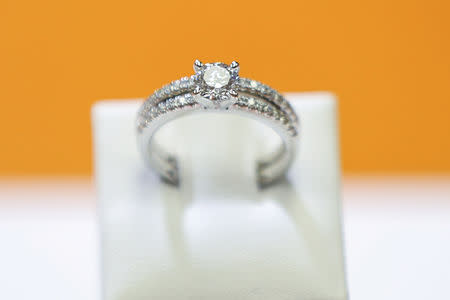De Beers says lab-grown diamond wholesale prices fall by up to 60 percent
By Barbara Lewis
LONDON (Reuters) - Wholesale prices for lab-grown diamonds have fallen by up to 60 percent since De Beers began selling synthetic stones for jewelry in September, CEO Bruce Cleaver said on Thursday, adding margins for the sector would continue to fall.
De Beers, part of mining group Anglo American, shocked the diamond industry last year when it announced it was reversing a decades-old policy of selling natural diamonds only for jewelry and synthetic stones for industrial uses.
Its Lightbox brand, created for the new synthetic venture, is starting small, selling 20,000 carats by the end of 2019, but De Beers has invested in a synthetic diamond factory in the U.S. state of Oregon, which should produce more than half a million rough carats a year when fully operational in 2020.
Already, the impact on synthetic pricing had been huge, Cleaver said, citing De Beers' analysis that showed an up to 60 percent fall in wholesale prices. He said the slide would continue as improved technology increases the quality and volume of lab-grown diamonds.
"The margins that were out there are not sustainable," Cleaver told Reuters in an interview. "I like to compare it to a flat screen TV. The first ones were very expensive and the quality was poor."
Cleaver however denied synthetic diamonds were cutting into the price of natural stones, which he says are a different product. "It's a perfectly legitimate business. It's just a different business," he says of lab-grown diamonds.
Much of the aim of De Beers, the world's leading diamond seller by value, in launching Lightbox is to differentiate diamonds grown in a laboratory from those found in the earth.
In contrast to the commodities that form the bulk of Anglo American's portfolio, demand for diamonds, which is listed in its results statement as among the company's "principal risks and uncertainties," is reliant on marketing.
Without giving numbers, Cleaver said De Beers would boost its marketing budget for natural stones this year, which already in 2018 was the highest in a decade at $166 million.
While Anglo American's overall core earnings for 2018 rose by 4 percent, De Beers' underlying EBITDA (earnings before interest, tax, depreciation and amortization) fell by 13 percent.
Cleaver attributed the fall to expenditure, including on Lightbox, as well as volatile market conditions, although he said the biggest markets for diamonds, the United States and China, were robust.
(Reporting by Barbara Lewis; Additional reporting by Arathy S. Nair in Bengaluru; Editing by David Holmes)




